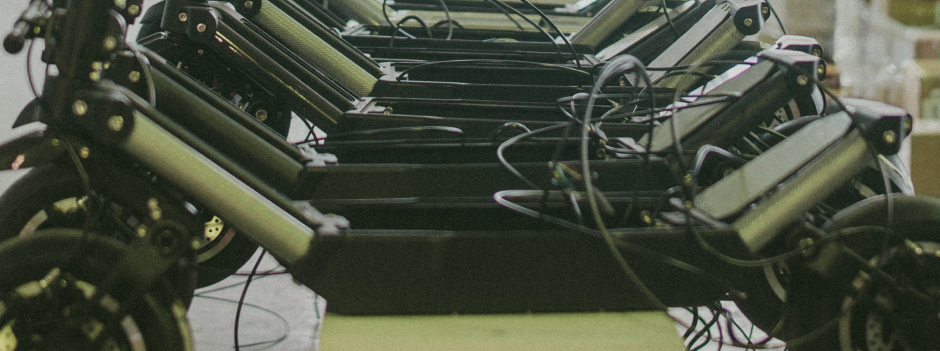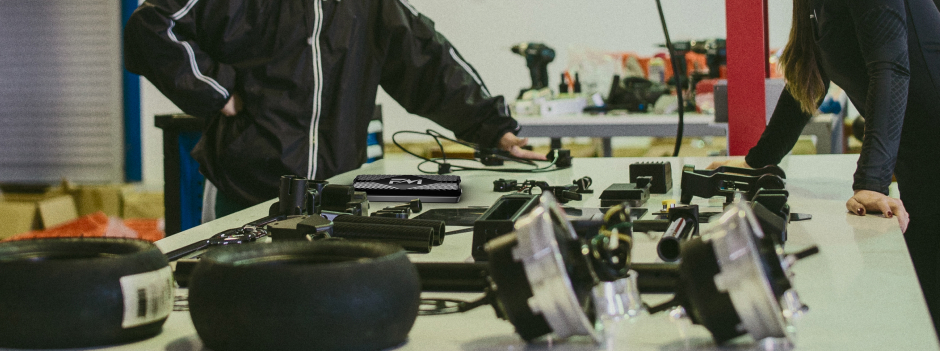
Maintaining the controller of your electric scooter is vital for ensuring performance, reliability, and longevity. The controller, being the central control system of your scooter, that oversees motor operation, battery management, and so much more. Keeping it in top condition means smoother rides and fewer problems. Here’s how you can keep your electric scooter’s controller in excellent shape.

One of the simplest yet most effective maintenance tasks is to keep the controller clean and dry. Moisture and dirt are among the biggest enemies of electronic components. Use a soft, dry cloth to wipe down the controller area and avoid direct water exposure when cleaning your scooter. If you’ve ridden in wet conditions, ensure the controller is thoroughly dried afterward.
Visual inspections can prevent many potential issues. Regularly check for any signs of wear, loose connections, or damages to the controller’s housing. Such problems, if left unattended, can lead to problems affecting the scooter’s performance or worse, leading to safety hazards. If you notice anything, it’s advisable to consult a professional for repairs or replacements.
Controllers can generate heat, especially during extended use or on challenging terrains. Making sure that your scooter’s controller has adequate ventilation is crucial for preventing overheating. Avoid blocking any vents on the scooter’s frame and consider parking in shaded areas during hot days to help keep temperatures down.
Loose or corroded connections can cause power and performance issues or unresponsive controls. Periodically check the connections to and from the controller for tightness and cleanliness. If you find corrosion, carefully clean the connections or replace the cables if necessary. It’s essential to disconnect the battery before attempting any work on electrical components.
Manufacturers often release firmware updates for electric scooter controllers that can improve performance, introduce new features, or fix bugs. Regularly check for such updates and apply them according to the manufacturer’s instructions. Keeping the firmware up to date can enhance your scooter’s functionality and extend its service life.
Since the controller and battery are closely linked, proper battery maintenance indirectly benefits the controller. Always charge your battery with the correct charger, avoid draining it completely, and store it in a cool, dry place if not used for extended periods. A well-maintained battery ensures stable power delivery to the controller, promoting efficient operation.

Though many maintenance tasks can be performed at home, some issues require professional attention. If you’re experiencing problems beyond basic troubleshooting, or if the controller needs internal repairs, don’t hesitate to take your scooter to a certified technician. Professional servicing can prevent further damage and ensure your scooter remains in prime condition.
Regular maintenance of your electric scooter’s controller is essential for ensuring your ride remains safe and enjoyable. By following these simple tips—such as keeping the controller clean and dry, ensuring proper ventilation, and seeking professional help when needed—you can significantly enhance the performance and lifespan of your electric scooter. Remember, taking good care of your scooter’s controller not only keeps your rides smooth but can also save you from costly repairs down the line.
Electric scooters have gained popularity as a convenient and environmentally friendly...
The age of electric scooters is becoming an eco-friendly way for...
In recent years, electric scooters have revolutionized urban mobility, providing a...

72 Volts 30 Ah (2016Wh charge)
Equipped with a long-lasting battery for extended rides and adventures

Dual 3000W BLDC Hub Motors
Powerful dual-engine setup delivers dynamic performance for performance seekers

6 hours fast charging so you can spend less time waiting and more time exploring

110 km/h
Top-tier speed capabilities for the rush of wind and the thrill of pace

100 km
Ready for long journeys with a generous range that keeps you moving

120 kg
Robust build accommodates significant weight, ensuring a ride for all

Disk brake with dual 8 pistons (Front and Rear), E-Brake Included

PMT Italian Slick & Stradale 11-inch tubeless
High-quality tires designed for optimal traction and control in various conditions.

1230 mm
Streamlined design ensures a compact footprint for agile urban navigation.

1290 mm
Elevated stance provides a commanding view of the road ahead.

266 mm
Narrow build offers convenient maneuverability through tight spaces.

540 mm
Quick-fold mechanism reduces the scooter to a compact form for easy storage and portability.

Carbon fiber and CNC 6061 aluminum

IPX67-rated components

Optimized for minimal air resistance

Enjoy peace of mind with a comprehensive warranty covering your scooter

Complete with essential accessories, get everything you need to hit the road immediately

Two 150 AMP Nano Elite X5K
Precision control at your fingertips with advanced, customizable settings."

Choose from classic color options to match your style

72 Volts 30 Ah (2016Wh charge)
Equipped with a long-lasting battery for extended rides and adventures

Dual 3000W BLDC Hub Motors
Powerful dual-engine setup delivers dynamic performance for performance seekers

6 hours fast charging so you can spend less time waiting and more time exploring

110 km/h
Top-tier speed capabilities for the rush of wind and the thrill of pace

100 km
Ready for long journeys with a generous range that keeps you moving

120 kg
Robust build accommodates significant weight, ensuring a ride for all

Disk brake with dual 8 pistons (Front and Rear), E-Brake Included

PMT Slick Italian 11-inch
High-quality tires designed for optimal traction and control in various conditions.

1230 mm
Streamlined design ensures a compact footprint for agile urban navigation.

1290 mm
Elevated stance provides a commanding view of the road ahead.

266 mm
Narrow build offers convenient maneuverability through tight spaces.

540 mm
Quick-fold mechanism reduces the scooter to a compact form for easy storage and portability.

Carbon fiber and CNC 6061 aluminum

IPX67-rated components

Optimized for minimal air resistance

Enjoy peace of mind with a comprehensive warranty covering your scooter

Two 150 AMP Nano Elite X5K
Precision control at your fingertips with advanced, customizable settings."

Choose from classic color options to match your style

60 Volts 30 Ah (2016Wh charge)
Equipped with a long-lasting battery for extended rides and adventures

Dual 3000W BLDC Hub Motors
Powerful dual-engine setup delivers dynamic performance for performance seekers

6 hours fast charging so you can spend less time waiting and more time exploring

110 km/h
Top-tier speed capabilities for the rush of wind and the thrill of pace

100 km
Ready for long journeys with a generous range that keeps you moving

120 kg
Robust build accommodates significant weight, ensuring a ride for all

Disk brake with dual 8 pistons (Front and Rear), E-Brake Included

Front and Rear Single Absorbers
Smooth rides guaranteed with a suspension system that absorbs shocks and jolts

PMT Italian Stradale 11-inch tubeless
High-quality tires designed for optimal traction and control in various conditions.

1170 mm
Streamlined design ensures a compact footprint for agile urban navigation.

1250 mm
Elevated stance provides a commanding view of the road ahead.

241 mm
Narrow build offers convenient maneuverability through tight spaces.

470 mm
Quick-fold mechanism reduces the scooter to a compact form for easy storage and portability.

Carbon fiber and CNC 6061 aluminum

IPX67-rated components

Optimized for minimal air resistance

Enjoy peace of mind with a comprehensive warranty covering your scooter

Complete with essential accessories, get everything you need to hit the road immediately

Safety first with a helmet that combines comfort with protection

Two 150 AMP Nano Elite X5K
Precision control at your fingertips with advanced, customizable settings."

Choose from classic color options to match your style

60 Volts 30 Ah (2016Wh charge)
Equipped with a long-lasting battery for extended rides and adventures

Single 3000W BLDC Hub
Powerful dual-engine setup delivers dynamic performance for performance seekers

6 hours fast charging so you can spend less time waiting and more time exploring

100 km/h
Top-tier speed capabilities for the rush of wind and the thrill of pace

100 km
Ready for long journeys with a generous range that keeps you moving

120 kg
Robust build accommodates significant weight, ensuring a ride for all

Disk brake with dual 8 pistons (Front and Rear), E-Brake Included

Front and Rear Single Absorbers
Smooth rides guaranteed with a suspension system that absorbs shocks and jolts

PMT Italian Stradale 11-inch tubeless
High-quality tires designed for optimal traction and control in various conditions.

1170 mm
Streamlined design ensures a compact footprint for agile urban navigation.

1250 mm
Elevated stance provides a commanding view of the road ahead.

241 mm
Narrow build offers convenient maneuverability through tight spaces.

470 mm
Quick-fold mechanism reduces the scooter to a compact form for easy storage and portability.

Carbon fiber and CNC 6061 aluminum

IPX67-rated components

Optimized for minimal air resistance

Enjoy peace of mind with a comprehensive warranty covering your scooter

One 150 AMP Nano Elite X5K
Precision control at your fingertips with advanced, customizable settings."

Choose from classic color options to match your style
One of our specialists will be in touch within the next 24-48 hours to assist you. We appreciate your interest in our scooters and look forward to speaking with you soon!”

72 Volts 30 Ah (2016Wh charge)
Equipped with a long-lasting battery for extended rides and adventures

Dual 3000W BLDC Hub Motors
Powerful dual-engine setup delivers dynamic performance for performance seekers

6 hours fast charging so you can spend less time waiting and more time exploring

110 km/h
Top-tier speed capabilities for the rush of wind and the thrill of pace

100 km
Ready for long journeys with a generous range that keeps you moving

120 kg
Robust build accommodates significant weight, ensuring a ride for all

Disk brake with dual 8 pistons (Front and Rear), E-Brake Included

PMT Italian Slick & Stradale 11-inch tubeless
High-quality tires designed for optimal traction and control in various conditions.

1230 mm
Streamlined design ensures a compact footprint for agile urban navigation.

1290 mm
Elevated stance provides a commanding view of the road ahead.

266 mm
Narrow build offers convenient maneuverability through tight spaces.

540 mm
Quick-fold mechanism reduces the scooter to a compact form for easy storage and portability.

Carbon fiber and CNC 6061 aluminum

IPX67-rated components

Optimized for minimal air resistance

Enjoy peace of mind with a comprehensive warranty covering your scooter

Complete with essential accessories, get everything you need to hit the road immediately

Two 150 AMP Nano Elite X5K
Precision control at your fingertips with advanced, customizable settings."

Choose from classic color options to match your style

72 Volts 30 Ah (2016Wh charge)
Equipped with a long-lasting battery for extended rides and adventures

Dual 3000W BLDC Hub Motors
Powerful dual-engine setup delivers dynamic performance for performance seekers

6 hours fast charging so you can spend less time waiting and more time exploring

110 km/h
Top-tier speed capabilities for the rush of wind and the thrill of pace

100 km
Ready for long journeys with a generous range that keeps you moving

120 kg
Robust build accommodates significant weight, ensuring a ride for all

Disk brake with dual 8 pistons (Front and Rear), E-Brake Included

PMT Slick Italian 11-inch
High-quality tires designed for optimal traction and control in various conditions.

1230 mm
Streamlined design ensures a compact footprint for agile urban navigation.

1290 mm
Elevated stance provides a commanding view of the road ahead.

266 mm
Narrow build offers convenient maneuverability through tight spaces.

540 mm
Quick-fold mechanism reduces the scooter to a compact form for easy storage and portability.

Carbon fiber and CNC 6061 aluminum

IPX67-rated components

Optimized for minimal air resistance

Enjoy peace of mind with a comprehensive warranty covering your scooter

Two 150 AMP Nano Elite X5K
Precision control at your fingertips with advanced, customizable settings."

Choose from classic color options to match your style

60 Volts 30 Ah (2016Wh charge)
Equipped with a long-lasting battery for extended rides and adventures

Dual 3000W BLDC Hub Motors
Powerful dual-engine setup delivers dynamic performance for performance seekers

6 hours fast charging so you can spend less time waiting and more time exploring

110 km/h
Top-tier speed capabilities for the rush of wind and the thrill of pace

100 km
Ready for long journeys with a generous range that keeps you moving

120 kg
Robust build accommodates significant weight, ensuring a ride for all

Disk brake with dual 8 pistons (Front and Rear), E-Brake Included

Front and Rear Single Absorbers
Smooth rides guaranteed with a suspension system that absorbs shocks and jolts

PMT Italian Stradale 11-inch tubeless
High-quality tires designed for optimal traction and control in various conditions.

1170 mm
Streamlined design ensures a compact footprint for agile urban navigation.

1250 mm
Elevated stance provides a commanding view of the road ahead.

241 mm
Narrow build offers convenient maneuverability through tight spaces.

470 mm
Quick-fold mechanism reduces the scooter to a compact form for easy storage and portability.

Carbon fiber and CNC 6061 aluminum

IPX67-rated components

Optimized for minimal air resistance

Enjoy peace of mind with a comprehensive warranty covering your scooter

Complete with essential accessories, get everything you need to hit the road immediately

Safety first with a helmet that combines comfort with protection

Two 150 AMP Nano Elite X5K
Precision control at your fingertips with advanced, customizable settings."

Choose from classic color options to match your style

60 Volts 30 Ah (2016Wh charge)
Equipped with a long-lasting battery for extended rides and adventures

Single 3000W BLDC Hub
Powerful dual-engine setup delivers dynamic performance for performance seekers

6 hours fast charging so you can spend less time waiting and more time exploring

100 km/h
Top-tier speed capabilities for the rush of wind and the thrill of pace

100 km
Ready for long journeys with a generous range that keeps you moving

120 kg
Robust build accommodates significant weight, ensuring a ride for all

Disk brake with dual 8 pistons (Front and Rear), E-Brake Included

Front and Rear Single Absorbers
Smooth rides guaranteed with a suspension system that absorbs shocks and jolts

PMT Italian Stradale 11-inch tubeless
High-quality tires designed for optimal traction and control in various conditions.

1170 mm
Streamlined design ensures a compact footprint for agile urban navigation.

1250 mm
Elevated stance provides a commanding view of the road ahead.

241 mm
Narrow build offers convenient maneuverability through tight spaces.

470 mm
Quick-fold mechanism reduces the scooter to a compact form for easy storage and portability.

Carbon fiber and CNC 6061 aluminum

IPX67-rated components

Optimized for minimal air resistance

Enjoy peace of mind with a comprehensive warranty covering your scooter

One 150 AMP Nano Elite X5K
Precision control at your fingertips with advanced, customizable settings."

Choose from classic color options to match your style
I, hereby acknowledge that I have read, understood, and agree to be bound by the Terms and Service (“Terms”) outlined by Flashmotors LTD in relation to the purchase and use of their scooters. By accepting these Terms, I affirm that I am of legal age and possess the necessary authority to enter into this agreement.
I specifically acknowledge and agree to the following:
1. Legal Notice: I am aware that the scooters provided by Flashmotors LTD are intended for personal use and must be operated in compliance with all applicable laws and regulations of Cyprus.
2. Withdrawal, Return, Refund, and Cancellation Policy: I understand that as per Cyprus law, I have the right to withdraw from the purchase contract within 14 days of receiving the Product. I agree to follow the specified procedures regarding withdrawal, return, and refund, including returning the Product in its original condition.
4. Complaint Policy: In the event of any issues or concerns with the Product, I agree to promptly contact the customer service team of Flashmotors LTD providing necessary information to assist in resolving the complaint.
5. Liabilities under Cyprus Law: I acknowledge that any liability or obligation arising from these Terms is subject to the laws and regulations of Cyprus. I understand that any dispute related to these Terms shall be subject to the exclusive jurisdiction of the courts of Cyprus.
6. Acceptance of Communication Terms: By providing your contact information and checking the designated boxes during account registration, or by entering your contact details on Flashmotors.com, you expressly consent to receive promotional and informational communications via SMS and email from Flashmotors.
I further acknowledge that Flashmotors LTD reserves the right to modify or update these Terms at any time, with the revised Terms becoming effective immediately upon posting on their website.
By accepting these Terms and Conditions, I confirm that I have reviewed and understood all the provisions contained therein, and I agree to be bound by them in their entirety.